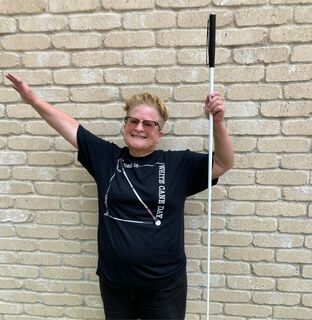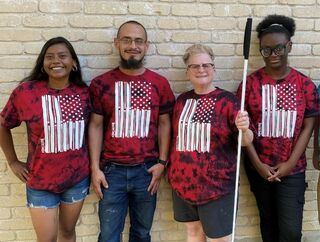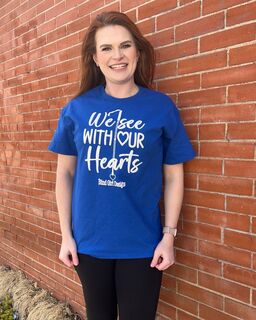Finding the “Keys to the Kingdom”
Beacon Stories
Tricia Waechter, who has retinitis pigmentosa (RP), refers to her white canes as the “keys to the kingdom.” Using a white cane has opened a whole new world for Tricia, and that is why her company, Blind Girl Designs, includes white canes on many of their apparel designs.
Tricia Waechter is the founder and CEO of Blind Girl Designs. Choosing this name for her business was obvious, as she’s proud of her blindness. Another integral part of Tricia’s vision loss journey is her white cane, and she wants to help normalize the use of white canes.

Tricia Waechter holding her white cane in one hand wearing a Blind Girl Designs t-shirt for White Cane Day.
Tricia was diagnosed with retinitis pigmentosa (RP) in the early 2000s after failing her visual field test several times at a routine eye doctor’s appointment. She went to a retina specialist who was hesitant to tell her the diagnosis because he didn’t want to say that there was no treatment or cure. After being diagnosed, Tricia’s family members were all genetically tested, and discovered that her two sisters and niece also have RP. They’ve all found it difficult to accept their RP diagnosis, but the shared experiences have been helpful in their journey of coping.
Tricia’s RP has progressed significantly in recent years, with her peripheral vision declining rapidly. In April of 2011, when Tricia and her family were visiting Knotts Berry Farm, she suddenly experienced the children all disappearing from her line of sight. She quickly discovered an organization nearby, the San Diego Center for the Blind, where they measured her for a white cane and gave her brief orientation and mobility training. After that, she would go to YouTube for how-to videos from orientation and mobility instructors, which she found to be an incredibly useful resource.
“They launched me on such an incredible journey with my white canes,” says Tricia. “I didn’t realize how much I was faking it, but once I had the cane, it was like the keys to the kingdom. It just unlocked everything and resolved so many of my issues with mobility.”
In 2018, Tricia started using a white cane full-time after her visual field went from about 20 degrees to 11 degrees in two years. Due to this, Tricia had to leave her corporate job in fashion, where she traveled to all seven continents and 48 countries, projecting fashion trends for years. After working in New York City for over 20 years, Tricia and her family moved to Houston, Texas, for what she thought was a temporary job. But after realizing she couldn’t get another job in her field due to her vision loss, she started filling her time by helping a friend who owned a small factory in the area. When designers would visit the factory, they’d typically meet in a conference room, so her white cane was usually under the table. But one day, one of their clients asked her to come to see their factory, and she knew it wasn’t safe for her to visit without her white cane. But her friend didn’t want the client to know she was blind, so she didn’t take her white cane and held his arm instead. But after the visit, Tricia felt so angry with this idea that her white cane was a problem.

Tricia and her team wearing their American flag red and black tie-dyed t-shirt.
“The fact is that I’m blind, and I was not okay with that rejection of my white cane,” recalls Tricia. “I decided then that I’m not ashamed of my blindness, and I’m not going to hide my white cane in any situation. There’s nothing to be ashamed of when using a white cane, and shame is no way to feel just because you’re visually impaired.”
After that experience, Tricia stopped working with her friend, and on the first day of 2021, Tricia decided she was going to start her own company.
“I have the brain, the experience, and I know how to build a clothing line, so why not start my own company,” said Tricia. “And I knew it was going to be called Blind Girl Designs because that’s what I am. And I’m proud of who I am.”
Tricia’s family have all been huge supporters of her vision loss journey and dreams, which is why Blind Girl Designs has evolved into a family business. Tricia’s niece, Molly Casey, created the website, while she and Tricia’s son, Robert, were the first models of the apparel. Robert and Tricia’s husband, Tom, helped with the designs, deliveries, and the conventions they showcase at almost every weekend.
By the end of April 2021, Blind Girl Designs had the full online storefront set up, including extensive detailed descriptions of all the products. A few months later, another blind entrepreneur, Laura Legendary, who founded a jewelry company called Elegant Insights, found Blind Girl Designs through social media and contacted Tricia about being a part of her “Let’s Go Shopping” event. Since the event was leading up to the holidays, Tricia knew they had to create holiday apparel to sell. So, she laid out all her white canes on the ground and played with them until she came up with a snowflake design. That was their first design, which was wildly well received. Tricia credits that event to launching the core of the Blind Girl Designs business.

Tricia’s niece Molly wearing their ‘We See With Our Hearts’ blue t-shirt that displays a white cane down the middle.
Now Blind Girl Designs has 25 different prints on t-shirts and hoodies, and 23 have white canes in the designs. The designs are also tactile, printed with 3D puff ink or vinyl ink, and the more you wash it, the more tactile it becomes.
Tricia has created her business exactly how she would want it as a visually impaired customer. So, shipping is free, and they send customers a bag with pre-paid postage for returns and exchanges.
“I built my business how I, personally, would want it to be,” says Tricia. “And I want to empower my customers to feel more independent. My business is all blind-friendly, making everything as simple as possible.”
And, as Tricia’s vision continues to deteriorate, she’s had to restructure her business in some ways, such as training her assistant designer, who is deaf, to be able to help more. But nothing will stop Tricia’s drive, and she plans to continue helping her customers and others in the community feel empowered.
“Blindness is just the beginning; it’s not the end,” says Tricia. “It’s just the beginning of a new part of our journey. We get to learn a whole new set of skills and a new way of thinking. My RP has allowed me to meet new people and see the world in a different way, and I see that all as really positive additions to my life. And it’s really healing for me to be around others in the blind community and share our spectrum of experiences.”




